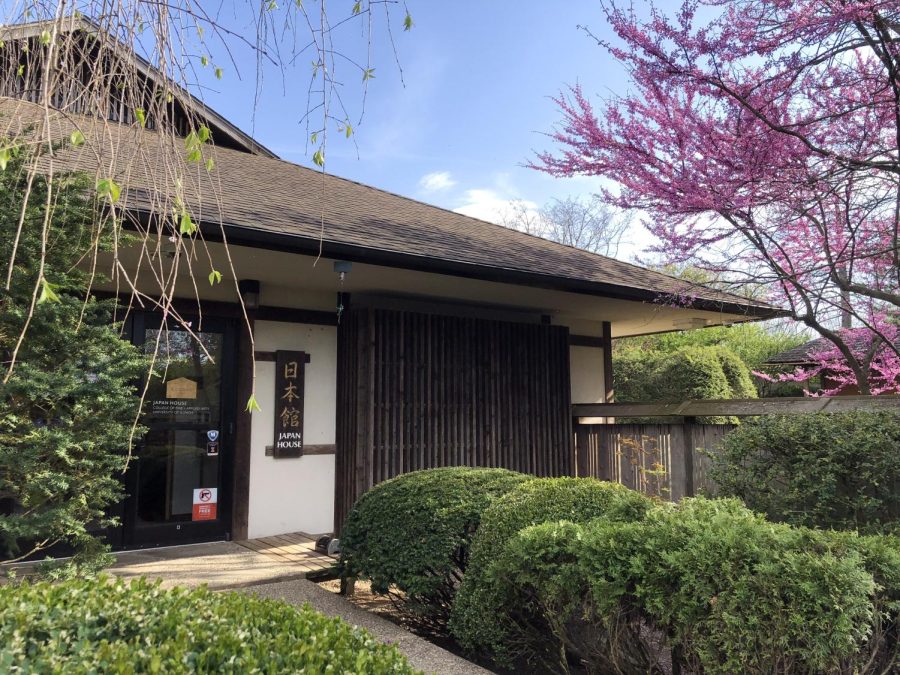UI‘s Japan House springs into celebration
The Japan House, located at 2000 South Lincoln Avenue in Urbana, has many sights to see and opportunities for guests to get involved.
Apr 26, 2023
Japan House provides an opportunity to embrace Japanese culture and educate the community, according to Japan House’s website.
One of the most popular aspects of Japan House is its cherry blossoms. However, the sakura cherry blossoms are not the only piece of nature to appreciate. The lack of sakura blooms this year did not dim people’s drive to visit Japan House.
Linna Niu, freshman in LAS, came to Japan House several weeks ago to appreciate the scenery.
“I didn’t see many cherry blossoms,” Niu said. “But I saw many blooming magnolias, and I still had a great time there with its beautiful plant landscape and cute ducks.”
Sakura Watch is not the only event taking place at Japan House. There are also tea ceremonies and garden tours taking place regularly to inform the community about traditional Japanese practices.
Get The Daily Illini in your inbox!
In a tea ceremony, visitors kneel on the tatami, learn Chado or the Way of Tea — one of the most ancient and revered arts of Japan — and taste matcha and Japanese sweets, according to Japan House’s website.
Skylar Mu, senior in LAS, once attended the tea ceremony with her Illini Kendo Club members.
“I learned about many interesting things in Japanese culture,” Mu said. “For example, the tea has to be served in order. And when I got my bowl of tea, I had to move it between me and the next guest, and then saluted while saying, ‘Please excuse me for drinking first.’”
There are many detailed practices to remember within a tea ceremony. Japan House encourages guests to wear white socks, as they are symbolic of purity. The ceremony lasts for an hour and the conductors of the ceremony follows traditions they have studied for years.
Even the bowls of tea have many intriguing details, according to Mu.
“In spring, the first guest’s bowl usually has sakura patterns because it is the season of sakura blooming,” Mu said. “When drinking (matcha), the host told us that the bowl’s side with the pattern should face outward, towards others, so that other guests can also appreciate the pattern on the tea bowl.”
Aside from tea ceremonies, the house also hosts a tour of their gardens.
Barrett Li, senior in LAS, participated in both offered tours.
“I’ve long found Japanese culture fascinating,” Li said. “Watching how the host gracefully prepared tea for us, I felt as if the world had slowed down, allowing me to find a moment of tranquility from the fast-paced academic life. It really helped me relax.”
The garden tour was led by a gardener who explained the designs of Japan House along the way.
“The garden itself is not huge,” Li said. “But it tells me a lot about Japanese culture. For example, there is a small jar placed in front of the house. The gardener told us that, in ancient Japan, tea houses often served samurai to drink tea. Generally, samurai wait outside. If a pair of large bamboo chopsticks is placed on the jar, it means that the tea house is ready to entertain guests.”
Li was also impressed by the many exquisite designs of Japan House. One such design, on a small lantern in front of the house, has Buddhist significance.
“The lantern has five layers, each representing earth, water, fire, air and spirit,” Li recalled. “They are the five elements of Buddhist cosmology.”
Besides these regularly offered activities, Japan House also holds special events.
Japan House had its annual Spring Open House on April 15. This year, the house invited Kevin Faris, a bonsai practitioner and landscaper. He gave a presentation to introduce bonsai art and did a potting demonstration for the visitors.
Diana Liao, Japan House’s education and engagement specialist, said she appreciates what the house brings to visitors.
“It’s just nice to see everyone going out and enjoying the garden with their family and friends,” Liao said.
A significant upcoming event hosted by the Japan House is the Matsuri Festival on May 6. Matsuri is held at the end of the spring semester and celebrates Japanese deities. This year, the festival happens to coincide and will also celebrate the 25th anniversary of Japan House and the Arboretum being at the University.
On that day, there will be many Japanese cultural performances, such as Ho Etsu Taiko drum group, martial arts demonstrations and hula. Traditional Asian cuisine and desserts will also be available for visitors.
Visitors can also experience art such as origami and ikebana, flower arranging. Visitors can get a chance to create with Japanese artist Niwa Zenkyu or large-scale calligraphy artist Seiran Chiba. This day of celebration will end with fireworks, according to officials from Japan House.
“We hope everyone comes and has a great time,” Liao said.






